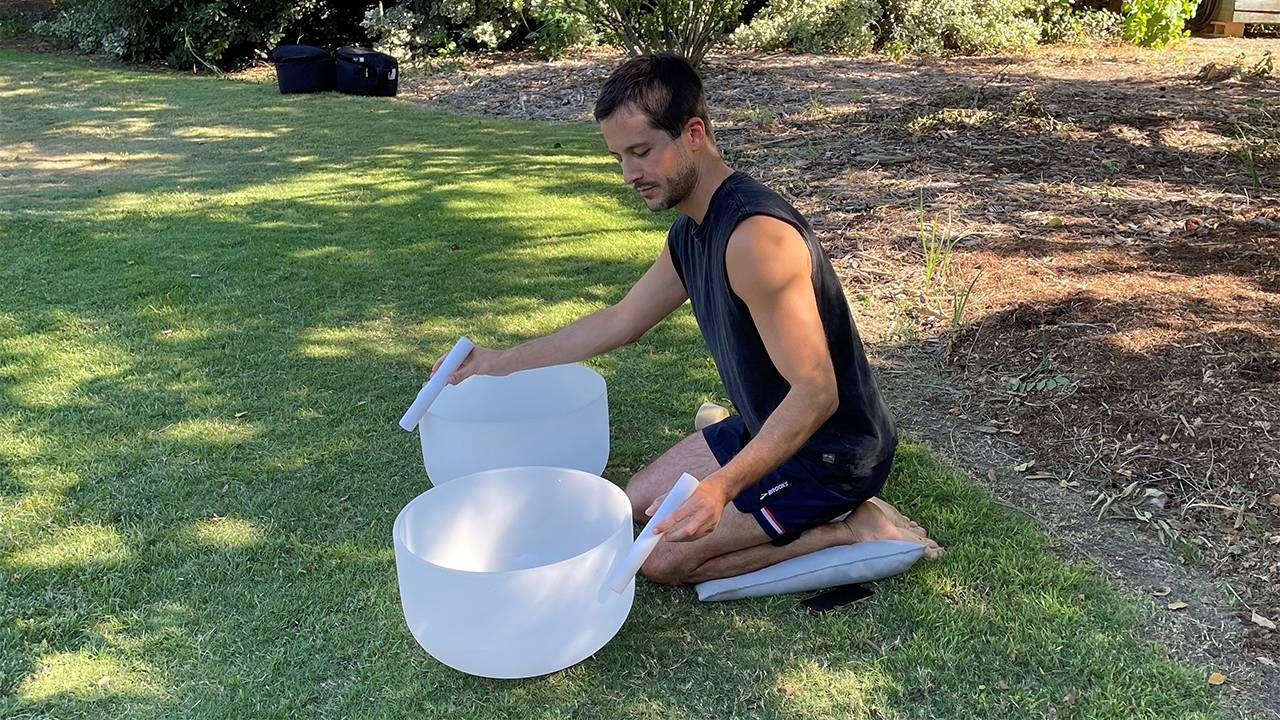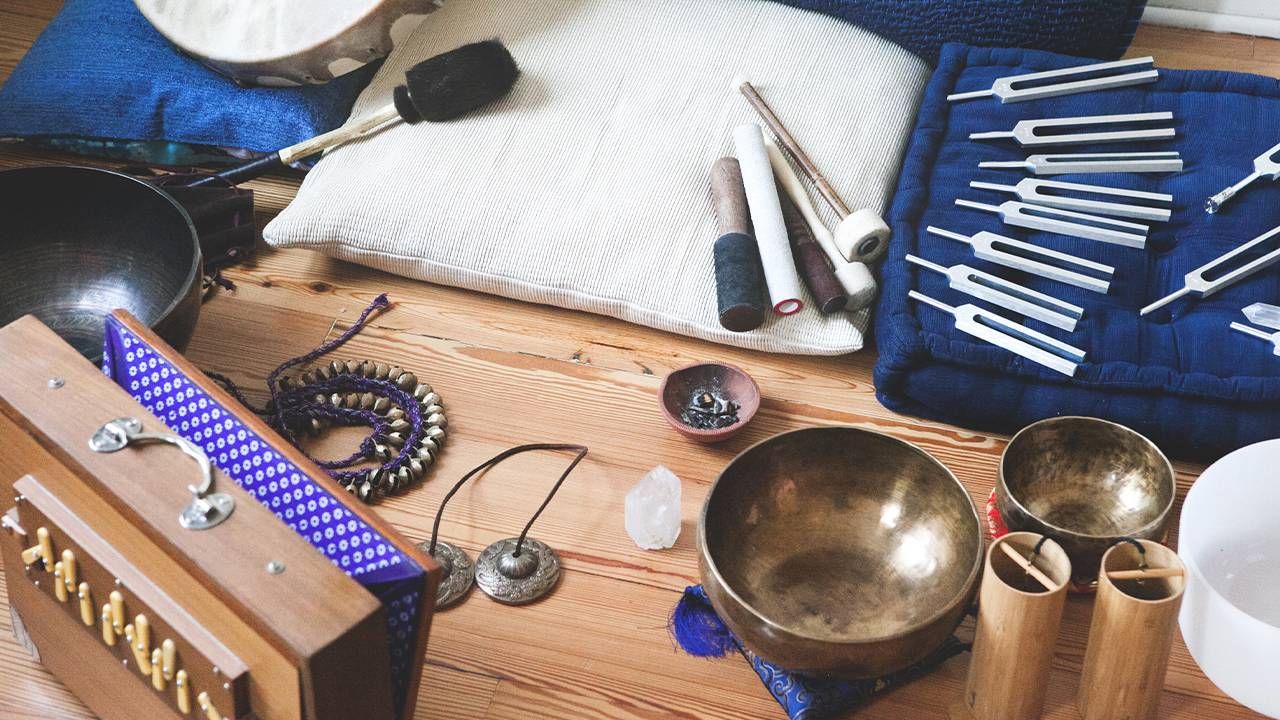How a Sound Bath Can Help You De-Stress
Sound baths bathe participants in sound waves and help some people quiet their minds
The 19-mile drive from my place to the Los Angeles County Arboretum in Friday afternoon traffic was bumper-to-bumper and nearly an hour long. But then, the scents of exhaust fumes and the sounds of desperate braking quickly faded away. Inside the 127-acre botanical garden, the lawns were lush and green, and the birds chirped quietly. Visual artist Jacinto Astiazaran was setting up for his session on the Arboretum's Zen Deck lawn.

Astiazaran placed two large white crystal bowls on the lawn. Beside them were two white tubes he calls strikers. He was ready to facilitate a sound bath.
While they can have meditation-like effects, sound baths are different from traditional meditation — and no water is involved. The experience "bathes" participants in sound waves. The expected results, Astiazaran says, include a blissful feeling of relaxation and ''a pleasant joy."
"It's about using sound as a mindfulness tool. That's one of the key things that people take away."
After inviting the 13 participants to stretch out and get comfortable on the mats or blankets they toted to the session — and to close our eyes or not — Astiazaran picked up the white tubes.
For the next 30 minutes, he struck the bowls, sometimes gently and other times more robustly, producing a symphony of sounds.
An Ancient Practice
Sound therapy is ancient, with Tibetans using singing bowls to facilitate meditation and other cultures claiming it heals ills. In the last five years, however, interest has increased and the sound bath approach is viewed as ''a tool that has value," says Susy Markoe Schieffelin, a Los Angeles self-described sound healer who leads both in-person and virtual sound baths.
How to explain the popularity? People are more stressed than ever, and there's been a big movement toward mindfulness over the last decade and more.
"And we are really at a point where mental health is coming to the forefront," says Schieffelin. She tells first-time sound bathers the experience may remind them of an "energetic deep tissue massage."
Sound baths, in some ways, are less intimidating than conquering meditation.
"When people think about meditation, it can be a daunting effort," says Nate Martinez, a sound therapy practitioner in New York City. But for sound baths, ''you don't need to know how to meditate or what to do. It provides guidance and context for how you can listen in a different way."
The sound, he says, can facilitate shifts in our brain-wave states, allowing us to shift from our normal awake state to a relaxed, meditative or even sleep state.
"In this setting, it's about using sound as a mindfulness tool," Martinez says. His students often say they are pleasantly surprised that a sound bath helps them quiet their minds. "That's one of the key things that people take away," Martinez notes.
''Everyone to some extent feels the vibrations [from the sounds],'' says Astiazaran. Some people who are ''into" chakras, believed to be the centers of the spiritual power in the body, tend to be more aware of the vibrations, he has found.
"There's no right or wrong way to experience a sound bath."
Astiazaran prefers to lead only in-person sound baths because, he said, they are ''more authentic — 3D versus 2D." However, Martinez and Schieffelin both lead virtual sound baths, and said they can deliver the same benefits as in-person ones.
Schieffelin had to shift quickly to virtual in 2018, when her sound bath session that was originally scheduled on the beach was impossible, as fires raged through Malibu and evacuations were ordered. "I had Zoom,'' she laughs, ''but barely anyone had Zoom at that point."
Even so, she switched the in-person session to Zoom. And her original list of about 30 boomed to 100 participants. Her online sound bath sessions continue to be popular.
What Does the Sound Bath Research Find?
California researchers looked at the effects of sound meditation on mood, anxiety, pain and spiritual well-being in 62 men and women, on average about 50 years old. Compared with before the sound exposure, afterward they had less tension, anger, fatigue and depressed moods. They reported more spiritual well-being.

In another study, researchers reviewed the findings of four published studies that looked at the effects of singing bowls used in sound bath settings. They found participants had improvement in distress, anxiety, depression, anger and confusion, as well as better blood pressure, heart rate and other measures.
However, while they found links with good outcomes, there's no evidence this approach ''heals" people, despite some claims to the contrary, the experts caution.
Tips for Sound Bath First-Timers
Those who lead the sound bath sessions describe themselves in a variety of ways — visual artist, sound healer, sound therapy practitioner. When you are looking for one, It's OK to ask where they trained or who they studied under and how many sound bath sessions they have done. But there's no standardized or universal training. "It's a bit of a Wild West," Martinez says.

There are certification programs, however, such as one he completed through Open Center, which now requires 130 hours of training on what it calls ''sound healing." But Martinez says he prefers not to use the term sound healing, because ''it implies someone is going to do something to you."
When you go, "have an open mind," Schieffelin says. "There's no right or wrong way to experience a sound bath." Dressing comfortably is suggested, including wearing socks to keep your feet warm. Lie with your head or feet near the bowls, whichever you prefer. You'll reap the same benefits in either position.
Know that costs vary greatly. For instance: At the Arboretum, the 30-minute session was $15 for members ($17 non-members). Other in-person, half-hour sessions are $50 or more. Schieffelin hosts a two-hour session on the beach for $55 and a 90-minute virtual session for $33. Some charge much higher fees than that.
Sound baths seem to be more common in urban areas, but are found in other locations, too. You can find them by checking Meetup groups or Facebook groups. Schieffelin also offers a free virtual sound bath.
First-Timers' Feedback
Among the first-timers at the recent Arboretum sound bath was Kristin Clark of nearby LaVerne, Calif. She pronounced it ''very relaxing." At first, the sounds of nearby birds distracted her, but soon their chirps seemed to belong with the other sounds.
Her friend, Megan Boling of nearby Upland, Calif., called the session ''therapeutic," adding "I have a very busy mind." The sound bath helped her to relax and quiet her mind.
As for me, I was so relaxed I nearly fell asleep, despite a day with my usual caffeine overload. I found it easier than trying to meditate at home — and didn't criticize myself for lack of focus as I can do when I feel I've ''failed" my meditation effort.

